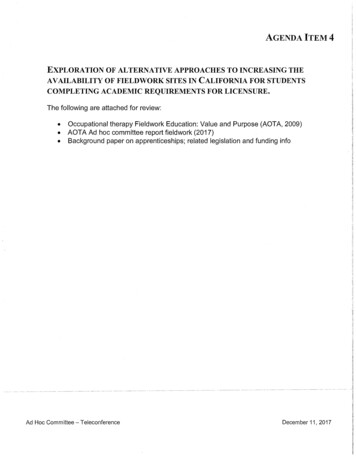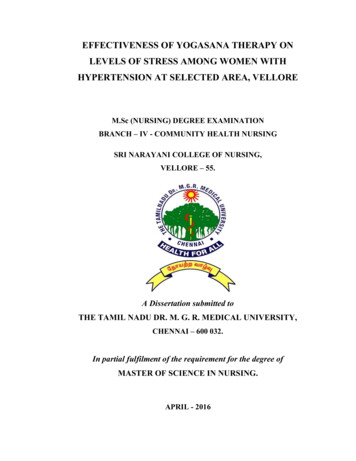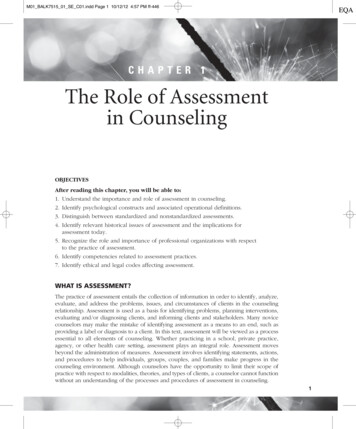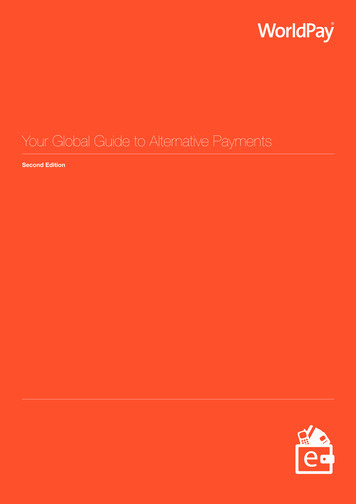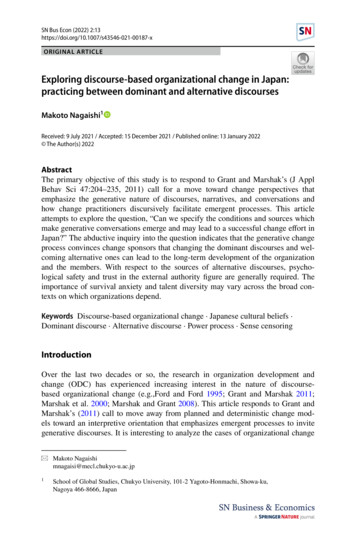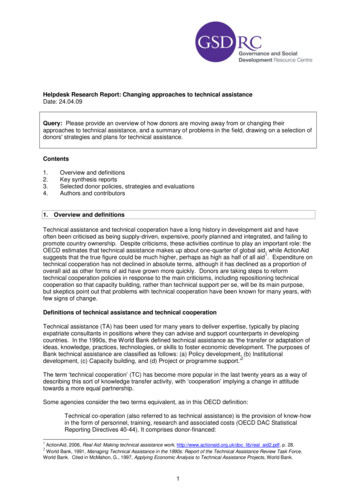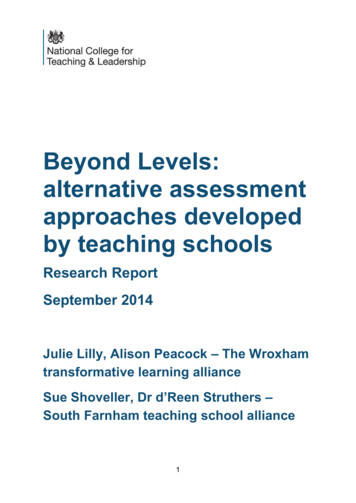
Transcription
Beyond Levels:alternative assessmentapproaches developedby teaching schoolsResearch ReportSeptember 2014Julie Lilly, Alison Peacock – The Wroxhamtransformative learning allianceSue Shoveller, Dr d’Reen Struthers –South Farnham teaching school alliance1
ContentsContents2List of figures4List of tables4Executive Summary5Introduction5Assessment tools to support individual progress through feedback5Assessment tools to capture progress6Use of technology to track progress6Recommendations7Section one: Introduction8Section two: Context9Section three: Methodology10Section four: Assessment tools to support individual progress12Visible learning approaches12Revised Bloom’s taxonomy13Mastery statements14Curriculum progression objectives15Feedback methods17Choice and challenge19Section five: Assessment tools to capture progress22SOLO Taxonomy grids22Revised Bloom’s Taxonomy23Use of (progressive) mastery statements24Marking grids of objectives related to new national curriculum in stages252
Summative testing26Working backwards from GCSE27Moderation28Special school assessment developments29Section six: Development of software for tracking progress31Section seven: Outcomes and impact for schools34Impact35Section eight: Key messages and conclusion37Joint Practice Development37Planning37Professional dialogue37Links to new national curriculum38Assessment approaches38Section nine: Moving forward / recommendations39References and key reading40Appendix A: audit summary of current assessment practices43Appendix B: teaching schools, regions and websites483
List of figuresFigure 1: Levels of understanding in SOLO Taxonomy13Figure 2: Revised Taxonomy table14Figure 3: Example of part of the Questioning Cards developed by Balcarras TSA 14Figure 4: Learning outcome grids, influenced by the Revised Bloom’s Taxonomy15Figure 5: ‘I need to ’ statements developed by Chimney House TSA16Figure 6: Example of learning objective statements17Figure 7: Feedback grids using ‘I can’ statements developed by Alban TSA18Figure 8: Personalised feedback grid incorporating both SOLO and Bloom’sTaxonomies19Figure 9: Feedback grids showing targets which can also be used as a markingcriteria (Balcarras TSA)20Figure 10: Proposed point system assessment tracking progress (to replace levelsfrom September 2014)26Figure 11: An example of ways of recording progress through incidental and informallearning from Mary Rose TSA30Figure 12: Pupil attainment recorded on SIMS to show status of achievement32List of tablesTable 1 Summary of all schools taking part in the research project9Table 2 Summary of existing assessment approaches within TSAs44Table 3 participating teaching school alliances484
Executive SummaryIntroductionTeaching schools, as key players in a school led system, were invited by theNational College for Teaching and Leadership (NCTL) in October 2013 to bid forsmall-scale research funding to explore alternative approaches to assessmentbeyond levels within their alliance schools. This report summarises the researchcarried out by 34 teaching school alliances across the country.The conclusions are based on the triangulated findings and careful analysis of: data collected at events where contributing schools shared their researchapproaches and findings examples of assessment tools created and trialled in alliance schools written research reports completed by schoolsFrom the information gathered, three priorities emerged: development of assessment tools to support individual progress development of assessment tools to capture and record progress use of technology to track attainment and progressThe full report gives details of methodology and examples from schools, along withappendices summarising the audit of existing assessment practices which someschools carried out and a list of all schools with web links. An additional resourcesummarising the outcomes and impact identified by schools participating in theresearch project is available separately.Assessment tools to support individual progress throughfeedbackThe consensus from participating schools about the importance of formativeclassroom assessment has been further supported in these research projects by arenewal of detailed focus on curriculum planning in preparation for introduction of thenew national curriculum. The detailed specificity within core subjects provided by thenew curriculum, offers the opportunity for assessment to be very closely aligned.‘Assessment for learning’ (AfL) has also been understood within many of theseprojects, as ‘assessment for teaching’. Through collaborative study, teachers haveengaged in critical reflection and discussion about the most appropriate assessment5
tools for different subject areas, age groups, and individuals. The full report providesexamples of the range of strategies that alliances developed to provide formativefeedback directly tailored to the new curriculum. These strategies include a range ofmethodologies including development of a mastery approach, use of detailedprogression objectives and enhanced pupil involvement in self-review.Whatever strategy has been considered, each teaching school in this project hasspoken of the value of participating in professional learning communities; to takeback control of the process of assessment. While external accountability wasrecognised as a necessity, teachers spoke of their revitalised approach to thepedagogy of assessment. Recognition was given to the benefit of collaborativeapproaches to formative assessment with consequent pupil ownership of theirlearning and progress.Assessment tools to capture progressSome schools concentrated on developing resources as a means of capturingachievement to record progressive development in understanding and skills. Suchwork either arose from an audit of existing assessment capture practices ordeveloped from new approaches to formative assessment as highlighted in theprevious section. In the absence of externally provided assessment ‘levels’,teaching schools have demonstrated that they have welcomed the opportunity toengage in researching alternatives that would more readily meet their local needs.There was a variety of approaches to measurement of progress across cohorts.Development of systems that will ultimately offer coherence and consistency acrossall schools was raised as a challenge. For example, some schools have adoptednumerical values, others alphabetical points systems. However, as revealed throughthe audits of existing practice (appendix A), this project has highlightedinconsistences within and across schools of existing assessment practice. Theremoval of levels has prompted a collaborative response amongst schools. Toolsthat were developed by alliances include SOLO taxonomy grids, progressivemastery statements and marking grids. The projects facilitated opportunities forteachers to become involved and have ownership over planning for classroomassessment systems that are closely aligned to specific curriculum subjects and mayallow pupils, parents and governors to receive feedback that is more meaningful.Use of technology to track progressA range of different technological options were explored across the alliance schoolstaking part. Some were used to capture formative assessments, often to share withparents, while others addressed the challenge of tracking.6
RecommendationsThe recommendations below are for both the department for education and schoolsto consider as alternatives to assessment levels are implemented within schools. A culture shift regarding the nature, range and purposes of assessment needsto take place, in recognition of the new opportunities provided both by the newcurriculum and the removal of levels. Conferences and seminars should be offered nationally, to enable all schoolsto confidently develop their assessment expertise and learn from each other.Detailed understanding of subject progression is needed to developassessment systems for foundation subjects. New tracking software should be developed to provide school leaders with ‘ata glance’ data that will enable monitoring of progress across year groups andover time. Some schools are already developing this, but it would be helpfulfor the system to have a range of options to choose from. The system wouldbenefit from access to peer reviewed commercial tracking systems that focusdirectly on the detail of the new curriculum. Further opportunities for grant funding would greatly assist communities ofschools to be ‘research active’ in the field of assessment.7
Section one: IntroductionIn May 2013, the Secretary of State announced: ‘as part of our reforms to thenational curriculum, the current system of ‘levels’ used to report children’s attainmentand progress will be removed. It will not be replaced.’ This policy decision followedrecommendations from the national curriculum Expert Panel (DfE: 2011) chaired byTim Oates. ‘Reforming assessment and accountability for primary schools’ stated‘schools should have the freedom to decide how to teach their curriculum and how totrack the progress that pupils make’ (DfE, 2014: p4). These announcements made itclear that central government was no longer going to dictate how schools shouldrecord and report progress between statutory tests.Teaching schools, as key players in a school led system, were invited by theNational College for Teaching and Leadership (NCTL) in October 2013 to bid forsmall-scale research funding to explore alternative approaches to assessmentbeyond levels within their alliance schools. This report summarises the researchfrom 34 teaching school alliances across the country. Following a contextualisationof the projects and an overview of the methodology adopted to collate this number ofprojects, this report then summarises the approaches schools developed or engagedwith, under the headings of: Assessment tools to support individual progress through feedbackAssessment tools to capture progressUse of technology to track progressThe final section reports the outcomes identified by the schools and the impact theyhave identified to date, before concluding with recommendations. More detailedoutcomes and impact evidence reported by the participating schools is available inaddition to this report.The alliances featured within this study have taken the opportunity presented by theremoval of national curriculum levels to review and trial a range of locally-developedtools and strategies. In many cases the school alliances are at an early stage in theirdevelopment of assessment resources, but this report aims to capture the learningfrom each group in order that others may build on this within their own community ofschools.8
Section two: ContextThe advent of a new national curriculum (DfE, 2014a) alongside a revised approachto recording and assessing progress (DfE, 2014b) offers a unique challenge andopportunity for the school led system. National curriculum levels had previouslyprovided a ‘best fit’ judgement. However, the new curriculum offers far more specificage-related content with an increased expectation of attainment. Schools taking partin this short study set out to see whether the existing levels were still helpful andrelevant or whether an alternative assessment framework could be developed thatwould align more closely with the new curriculum.Table 1 Summary of all schools taking part in the research projectPrimary(incl early years)SecondarySpecialschoolTotalLead school1715234Cluster schools13658102041537312238SchoolTotalThe 34 participating teaching schools varied in the way they worked across theiralliances and who was involved. These can be summarised as: cross-phase (primary-secondary)cross school types (mainstream-secondary)both urban and rural settings as well as across settingsresearchers working with headteachers who led their own school teamscollaborative communities of practice (teachers with external research support)variety of stakeholder collaborations – some including a variety ofcombinations of parents, pupils, and teachers9
Section three: MethodologyThe work of the teaching school alliances (TSAs) was jointly co-ordinated by theSouth Farnham Teaching School Alliance and the Wroxham TransformativeLearning Alliance. Although the methodology for co-ordination was different for thetwo groups, the approach was underpinned by a commitment to support each groupof schools to follow through the particular research approaches they had identified,offering guidance and research tools and processes.To manage the geographical spread of teaching schools, an East-West divide wasmade. The western group of TSAs held midpoint meetings in the north, south andmiddle of England. These gatherings offered the opportunity for schools to presenttheir research thus far and to learn from each other about approaches, challengesand shared areas of interest. A writing frame was offered to support the articulationand summarising of this work at both the mid-point and conclusion of the project, toensure this report could draw on the schools’ own words. The eastern group heldtwo conference days in late summer at which schools presented their work, and fromwhich information was amassed for this report. This group used social media to keepin touch with developments as they occurred across alliances.Alliances set to work in a wide variety of ways. The majority gathered interestedparties together from their alliance schools and began to plan projects that wouldallow for new thinking to emerge. Many groups revisited their own beliefs about thecore purposes of assessment and used this as a guiding strategy as to which area todevelop. One alliance began by engaging in a study of the history of assessmentrelated to the previous national curriculum. This was done as a means of trying tounderstand how and why assessment needed to change away from levels as therewas a degree of hostility to this policy change amongst schools within this alliance.While some alliances worked directly with colleagues from higher educationinstitutions (HEIs) or local authorities, others coordinated a variety of differentprojects within their schools.TSAs collected data in a variety of ways. Some schools developed surveyinstruments and conducted semi-structured interviews prior to beginning work. Manyschools engaged in a detailed audit of existing practice (Appendix A). Colleagues setabout sharing classroom practice and approaches to tracking, monitoring andmoderation. Methods of enquiry included film, classroom visits, close scrutiny of thenew curriculum programmes of study, subject specific working parties, piloting ofnew approaches and review. Several alliances based their work around notions of‘mastery’. In some groups of schools new software and innovative use of technologyto enhance assessment was developed.Increased collaboration and shared professional understanding through dialoguewas often cited as one of the key benefits from undertaking these enquiries.10
The findings drawn from end of project reports and presentations were thenthematically grouped using the Framework for Qualitative Data Analysis (Miles &Huberman,1994). This enabled a layer of analysis of the data that revealed recurringthemes and approaches.Social mediaIncreasingly teachers and school leaders are turning to social media such as twitteror blogs to share and discover resources to support innovation. At the outset of theproject a new twitter account @beyondlevels was set up to provide a forum for onlinedebate about assessment. The account is followed by organisations such as theDepartment for Education (DfE), Ofsted and the Teaching Schools Council. Leadingeducational bloggers are referenced from the twitter account enabling followers toaccess think pieces by a wide range of colleagues nationally and internationally. Akey benefit of this emerging space for collaboration and debate is the opportunity toengage with others who are driven by the imperative of sharing practice as acollective endeavour for educational improvement.See links to the following schools in appendix B: The Wroxham TransformativeLearning alliance, Tudor Grange Academy Solihull11
Section four: Assessment tools to supportindividual progress‘An assessment functions formatively to the extent that evidence about studentachievement is elicited, interpreted and used by teachers, learners, or theirpeers to make decisions about the next steps in instruction that are likely to bebetter, or better founded, than the decisions, they would have made in theabsence of that evidence.’Wiliam, D. 2011, p. 43The following approaches were developed by schools as a means of using formativeassessment to enhance the progress achieved by individual children and students.We have illustrated approaches with examples to offer clarity; many schoolshowever are currently still at the development stage. In addition, we have includedlinks to each teaching school where further information and detail can be accessed.Visible learning approachesWhen teaching and learning are visible – that is, when it is clear what teachers areteaching and what students are learning, student achievement increases. Asfeatured in ‘Visible Learning for Teachers’ (Hattie, J. 2012) ways to make learningand teaching more explicit were explored by several schools. These included selfand peer assessment initiatives, which sought to offer students increasing agencyover their learning. In particular the SOLO Taxonomy as supported by the materialscreated by Pam Hook (2011, 2012, 2013) and widely used in New Zealand, wasapplied to a variety of primary, secondary and special school settings.12
Figure 1: Levels of understanding in SOLO Taxonomy(As adapted by Severn TSA from Hook, P & Mills J. (2011) SOLO Taxonomy: A Guide for SchoolsBook 1 Essential Resources Educational Publishers, NZ)The materials and approach were found to be valuable both to assist teachers intheir planning and pupils in their active engagement in learning activities, leading toenhanced peer and self-assessment skills being developed by the pupils and moredifferentiated approaches for personalising learning.See links to the following schools in appendix B: Alban TSA, Ashford TeachingAlliance, Teaching School Alliance West Kent and West Sussex (TAWKE), Alliancefor Learning, Lightwoods TSA, Parbold Douglas CE Academy Teaching Alliance,The Pioneer TSA, Severn TSA, Tudor Grange Academy Solihull, Bishop RawstorneChurch of England (CofE) Academy TSA, Chimney House TSA, South FarnhamTSA, Ebor TSARevised Bloom’s taxonomyUnlike the former Bloom’s taxonomy (1956) the Revised Taxonomy (Krathwohl,2002), is a two-dimensional framework: knowledge and cognitive processes. Incombination, the dimensions form a very useful table. Using the table to classifyobjectives, activities, and assessments provides a clear, concise, visualrepresentation of a particular course or unit.13
Figure 2: Revised Taxonomy tableOnce completed, the entries in the taxonomy table can be used to examine relativeemphasis, curriculum alignment, and missed educational opportunities. Based onthis examination, teachers can decide where and how to improve the planning ofcurriculum and the delivery of instruction.Various interpretations of this revised taxonomy have led schools to develop toolssuch as ‘learning ladders’, ‘stepping stones’, ‘command words’ and strategicapproaches to questioning. For example Balcarras TSA has used ‘Questioningcards’:Figure 3: Example of part of the Questioning Cards developed by Balcarras TSPSee links to the following schools in appendix B: Portsmouth TSA, PrimaryExcellence TSA, Alliance for Learning, Balcarras TSP, Bishop Challoner TSA,Chimney House TSA, Lightwoods TSA, The Pioneer TSA, Primary Excellence TSA,Salop TSA, Severn TSA, South Farnham TSA, Ebor TSAMastery statementsMany schools were keen to involve children and young people in formativeassessment using mastery statements. These often took the form of ‘I can’ grids,that related directly to the new curriculum. This approach also included developmentof tools such as skill ladders, milestones (or tinier inch-pebbles) and assessment14
grids related to specific units of work (see link to Bishop Challoner TSA whodeveloped specific mastery statements in History).Figure 4: Learning outcome grids, influenced by the Revised Bloom’s TaxonomyDomainPre Y7 MasteryY7 MasteryY8 MasteryY9 MasteryGCSECausationMasteryStudents canStudents canStudents have aStudents can fullyStudents canidentify and describeexplain short andmore in depthexplain long and shortfully prioritisesingle or multiplelong term causes ofunderstanding of theterm causes andcauses andcauses and / orevent, recognisingconsequences ofconsequences withinconsequencesconsequences ofthat these eventsevents and long andits wider context, andof events inevents. Studentshave short and longshort term impact ofcan explain thetheir widersuggest that allterm consequences.both cause andsignificance of somehistoricalcauses are of equalStudents will beginconsequence.factors over others.context.importance, usuallyto explore the linksStudents will be ableStudents can do this inattributed to peoplebetween theseto explain the linksits wider contextand not underlyingcauses/and suggeststhereby strengtheningforces. Students willconsequences.reason why sometheir judgementnot usuallyfactors are moreregarding significance.recognise ainfluential thanrelationship betweenothers.them.See links to the following schools in appendix B: Alban TSA, Ashford TeachingAlliance, Ebor TSA, Harrogate and Rural TSA, Outwood Institute of Education, TheStourport TSA, Alliance for Learning, Bishop Challoner TSA, Silk Alliance, SouthFarnham TSA, Wigmore School TSACurriculum progression objectivesProgression objectives for mathematics and English have been developed by manyof the teaching school alliances. Taking the detail within the national curriculumprogrammes of study it is possible to identify key objectives that will be taught andcan be assessed throughout the year. Many schools drew on the examples ofprogression objectives produced by the national association of headteachers (NAHT)to develop detailed mini-statements of achievement, providing an opportunity forchildren to self-assess alongside the teacher’s judgement of progress. This alsoprovides a means of giving feedback to parents about aspects of the curriculum thathave been understood by the child, with information about other areas that requirefurther practice. Ebor TSA developed an assessing pupil progress (APP)-style grid toreview progress in mathematics providing an ‘at a glance’ assessment of what eachchild is achieving throughout the year. Chimney House TSA developed ‘I need to.’statements which were shared between home and school successfully.15
Figure 5: ‘I need to ’ statements developed by Chimney House TSADetailed understanding of curriculum progression within the foundation subjects is anarea that some schools spent time developing. The skill of understandingprogression is closely linked to pedagogical subject knowledge. In some alliances,specialist leaders of education (SLEs) led a working group within their specialistsubject area. The work of subject associations was found useful by many and therewas reference to the Expert Subject Advisory Group website1 as a useful resourcefor access to advice about implementation of the new curriculum.Recognition was given that recording progress within specific foundation subjectsoften required an approach that may differ from one subject domain to another. Theopportunity to work collaboratively across phases to build understanding of children’sdetailed progress within subjects was an area of development that colleagues foundvery useful and enlightening.1www.expertsubjectgroups.co.uk16
Figure 6: Example of learning objective statementsHow progression might be supported in specific special school contexts alsofeatured with more details P-statements emerging.See links to the following schools in appendix B: Alban TSA, Ashford TeachingAlliance, Ebor TSA, Harrogate and Rural TSA, Outwood Institute of Education, TheStourport TSA, Together to Succeed (T2S), TAWKE, Balcarras TSP, ChimneyHouse TSA, George Abbot TSA, Lightwoods TSA, Silk Alliance, South FarnhamTSA, Wigmore School TSA, Leading Learning Forward, Harrogate and Rural TSAFeedback methodsFeedback pro-forma in various formats were produced by almost all alliances toenable children and students to understand how to improve their work throughbuilding on formative feedback.The Cambridge and Suffolk Schools Alliance (CASSA) drew upon the Teaching andLearning Research Programme2 (2006) principles of ‘making learning explicit’ and‘promoting learning autonomy’. Using these principles as a reference point they setabout devising protocols for peer review and re-drafting during a piece of work ratherthan waiting until the work was complete for a summative response from the teacher.Marking ladders were developed as a scaffold for peer feedback and time was givenduring most lessons for dialogue between pupils to enable this process to haveimpact. Pupil dialogue combined with teacher feedback was described by theteachers as very powerful. Examples of pupils’ work that had been re-draftedfollowing feedback illustrated the increase in quality that was achieved. Thisapproach was successfully implemented across a range of schools with classes fromYear 2 through to Year 9; encapsulated in the mnemonic TOWER: Talk - Organisevisually – Write - Edit (and critique) - ReflectAlban TSA developed feedback grids using ‘I can’ statements and teachersummative responses. These grids were stuck into pupils’ books and were used to2www.tlrp.org17
assess progress at the beginning and end of each unit of work. Feedback for eachobjective allowed the pupil to see whether they were foundation, developing, secureor excellent. The benefit of this process for the schools was that assessment couldtake place in a range of different modes, thereby ensuring that all learning activitiescontributed to the assessment process throughout the year. The alliance also used asystem of ‘medal and mission’ for self assessment. Pupils are asked to reflect whatthey did well (medal) and what they could improve (mission), teachers and parentssupport this process and teachers commented that this had proved highly motivatingfor pupils.Figure 7: Feedback grids using ‘I can’ statements developed by Alban TSASome schools use learning review meetings between children, teachers and parents.These twice yearly meetings consist of a dialogue about progress within specificareas of the curriculum, evidenced with examples of written work. Next steps forimprovement and challenge are agreed and recorded at each meeting.Others trialled a range of feedback models influenced by evidence from Hattie’svisible learning insights e.g. Alliance for Learning and Primary Excellence TSA,developed ‘Feedback booklets’:“Pupils were given an opportunity to write in a feedback booklet which was anopen dialogue between teacher and pupil about what the child understands ofa lesson/sequence of lessons. The books provided clear evidence of when a18
child misunderstood a concept, therefore teachers could continually supportthe learning by adapting planning and lessons and implementinginterventions.”Primary Excellence TSAPersonalised feedback grids featured in a number of projects; schools had integratedideas from both SOLO and Revised Bloom’s Taxonomies.One such example from Bishop Rawstorne CofE Academy TSA shows a griddeveloped and trialled in design technology:Figure 8: Personalised feedback grid incorporating both SOLO and Bloom’s TaxonomiesSee links to the following schools in appendix B: Alban TSA, Ashford TeachingAlliance, Ebor TSA, Harrogate and Rural TSA, Outwood Institute of Education, TheStourport TSA, T2S, TAWKE, The Wroxham Transformative Learning Alliance,Balcarras, Bishop Challoner TSA, George Abbott TSA, Primary Excellence TSA, SilkAlliance, Tudor Grange Academy Solihull, Wigmore School TSAChoice and challengeBuilding on the ‘learning without limits’ work of Hart et al (2004), Swann et al (2012)some schools have begun to actively engage pupils in self-assessment whenselecting practice tasks. Pupils re-draft and review the quality of their work anddetermine their next steps in learning through dialogue with peers, teachers and19
parents. The Wroxham TSA has used this alternative approach to assessmentdriven by levels for many years. Their research involved an ethnographic study of sixprimary schools nationally that had begun to trial this method as a means of usingassessment as a driver for change. Ultimately, this inclusive pedagogy seeks to builda culture of intrinsic ambition and challenge amongst all children.Resisting labelling and encouraging pupils to challenge themselves in a climate oftrust, means that teachers also need to raise expectations of what may be achieved.Dylan Wiliam argues that ‘it’s generally easier to get people to act their way into anew way of thinking than it is to get people to think their way into a new way ofacting’3 . There was evidence of both approaches to new professional learning withinthe Wroxham study.Balcarras TSP worked with feedback grids which showed targets as criteria also for‘marking’ but these offer choice to the pupils:Figure 9: Feedback grids showing targets which can also be used as a marking criteria(Balcarras TSP)The Silk Alliance used growth mindset (including Carol Dweck and Guy Claxton)taxonomies to engage pupils in visible learning / building learning power approaches(early years foundation stage – year 6) to ensure less rigidity of thinking to ‘fixed’ability school cultures. Chimney House TSA similarly engaged with Claxton’s notionof how the feedback dialogue can support and challenge pupils.3http://www.dylanwiliam.org/Dylan Wiliams website/Papers files/Cambridge AfL Keynote
transformative learning alliance . Sue Shoveller, Dr d’Reen Struthers – South Farnham teaching school alliance . 2 Contents Contents 2 List of figures 4 List of tables 4 Executive Summary 5 Introduction 5 Assessment tools to support individual progress through feedback 5 Assessment t
